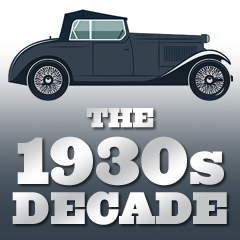|
Early Gangster Films at Warners:
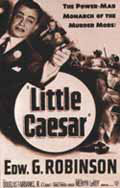 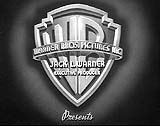 Warner
Bros. developed its own style by producing gritty narratives, social problem
pictures and a succession of tough, realistic gangster movies in the sound
(and Depression) era, reflecting the era's shaken confidence in authority
and the country's social traditions. The major stars of Warners to emerge
in the 30s were: Muni, Flynn, Edward G. Robinson, Cagney, Bogart, and
Davis (with Warners from 1931-1949). Warner
Bros. developed its own style by producing gritty narratives, social problem
pictures and a succession of tough, realistic gangster movies in the sound
(and Depression) era, reflecting the era's shaken confidence in authority
and the country's social traditions. The major stars of Warners to emerge
in the 30s were: Muni, Flynn, Edward G. Robinson, Cagney, Bogart, and
Davis (with Warners from 1931-1949).
Always an early adopter, Warners launched the gangster genre with Mervyn
LeRoy's Little Caesar (1930) - a star-making
role for Edward G. Robinson as snarling, fast-talking mobster Caesar Enrico
Bandello who met his inevitable fate with the words, "Mother of mercy,
is this the end of Rico?" William Wellman's The
Public Enemy (1931) starred a swaggering, cocky urban gangster
portrayed by James Cagney (in his first film after a stint as a song-and-dance
man in vaudeville) - in a film most-remembered for the scene in which
the hoodlum abusively stuffed a grapefruit half into Mae Clarke's face,
and the scene of Cagney's death at his mother's door.
 Billionaire
Howard Hughes' and United Artists' hard-hitting gangster film Scarface
(1932), directed by Howard Hawks and produced outside the Hollywood
system, was delayed for two years due to censorship, and was required
to add the qualifying sub-title "The Shame of the Nation" to its main
title. With a script from hard-hitting newspaperman Ben Hecht, it starred
Paul Muni (who was better known for playing historical characters such
as Emile Zola and Louis Pasteur) as a psychopathic Chicagoan crime boss
(based upon Al Capone). The spectacular and controversially-violent film
(with incest in a sub-plot) included a record number of killings - 28,
and inventively used a visual "X" motif throughout to signal that a murder
was imminent. Billionaire
Howard Hughes' and United Artists' hard-hitting gangster film Scarface
(1932), directed by Howard Hawks and produced outside the Hollywood
system, was delayed for two years due to censorship, and was required
to add the qualifying sub-title "The Shame of the Nation" to its main
title. With a script from hard-hitting newspaperman Ben Hecht, it starred
Paul Muni (who was better known for playing historical characters such
as Emile Zola and Louis Pasteur) as a psychopathic Chicagoan crime boss
(based upon Al Capone). The spectacular and controversially-violent film
(with incest in a sub-plot) included a record number of killings - 28,
and inventively used a visual "X" motif throughout to signal that a murder
was imminent.
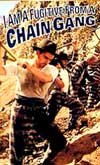 After
the previous three gangster films, the genre branched out to other uncompromising,
"serious" social drama films, including Best Picture-nominated
I Am A Fugitive From a Chain Gang (1932)
that dealt with such subjects as chain gangs and prison reform (an expose
specifically referring to Georgia's brutal treatment) and promoted social
reform of a corrupt court system. William Wellman's social problem film
Wild Boys of the Road (1933) told the story of two disillusioned
teens forced to travel cross-country rails to find work during the height
of the Depression. Michael Curtiz' hard-hitting melodrama Black Fury
(1935) also starred Paul Muni as a coal miner caught in the middle
of a labor dispute. In one of his first important screen roles, Humphrey
Bogart re-created his stage role as gangster Duke Mantee in a starring
film role opposite Bette Davis in The Petrified Forest (1936).
James Cagney starred as a gangster who grew up on the wrong side of the
tracks, in Michael Curtiz' Angels With Dirty Faces
(1938). At the end of the decade, Cagney was gunned down in the
finale of The Roaring Twenties (1939) in
another gangster role. After
the previous three gangster films, the genre branched out to other uncompromising,
"serious" social drama films, including Best Picture-nominated
I Am A Fugitive From a Chain Gang (1932)
that dealt with such subjects as chain gangs and prison reform (an expose
specifically referring to Georgia's brutal treatment) and promoted social
reform of a corrupt court system. William Wellman's social problem film
Wild Boys of the Road (1933) told the story of two disillusioned
teens forced to travel cross-country rails to find work during the height
of the Depression. Michael Curtiz' hard-hitting melodrama Black Fury
(1935) also starred Paul Muni as a coal miner caught in the middle
of a labor dispute. In one of his first important screen roles, Humphrey
Bogart re-created his stage role as gangster Duke Mantee in a starring
film role opposite Bette Davis in The Petrified Forest (1936).
James Cagney starred as a gangster who grew up on the wrong side of the
tracks, in Michael Curtiz' Angels With Dirty Faces
(1938). At the end of the decade, Cagney was gunned down in the
finale of The Roaring Twenties (1939) in
another gangster role.
Universal's Horror Films:
 Escapist
entertainment emerged at Universal, one of the minor film studios during
the "Golden Age of Hollywood." Universal produced a Best Picture winner
in the second Academy Awards ceremony - a serious anti-war polemic, All
Quiet on the Western Front (1930) - the controversial, landmark
film was denounced and banned in numerous European countries. It was a
remarkable film that used 'advanced' sound dubbing techniques - incorporating
sound effects, dialogue, and music on one soundtrack. Escapist
entertainment emerged at Universal, one of the minor film studios during
the "Golden Age of Hollywood." Universal produced a Best Picture winner
in the second Academy Awards ceremony - a serious anti-war polemic, All
Quiet on the Western Front (1930) - the controversial, landmark
film was denounced and banned in numerous European countries. It was a
remarkable film that used 'advanced' sound dubbing techniques - incorporating
sound effects, dialogue, and music on one soundtrack.
The
studio had its greatest success with its cycle of classic horror films.
Actually, the horror film releases were the first modern horror
movies (a resurrected genre), beginning with Tod Browning's Dracula
(1931) (expressionistically filmed by Karl Freund). The film starred
Bela Lugosi in a star-making role as the vampire Count Dracula, a creation
of Irish writer Bram Stoker in his 1897 novel Dracula. [Dracula
would become the most frequently-portrayed character in horror
films.]
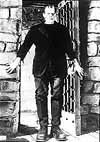 Universal's next feature was James Whale's gothic Frankenstein
(1931) with an unbilled Boris Karloff as the MONSTER, and then
Karloff also starred as the unforgettable Egyptian corpse in German Karl
Freund's directorial debut film The Mummy (1932). Universal's next feature was James Whale's gothic Frankenstein
(1931) with an unbilled Boris Karloff as the MONSTER, and then
Karloff also starred as the unforgettable Egyptian corpse in German Karl
Freund's directorial debut film The Mummy (1932).
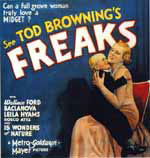 To capitalize on Universal's success with their horror films in 1931,
Browning's next film was MGM's shocking, bizarre and unsettling Freaks
(1932) - deliberately casting real-life pinheads (microcephalics),
circus freaks and mis-shapen dwarves to sensationalize its content. Two
of its taglines proclaimed: "Do the Siamese Twins make love?"
and "Can a full-grown woman truly love a midget?" In the vengeful,
unforgettable ending of the grotesque film, the cruel Cleopatra is mutilated
and changed into a legless, chicken-like creature as revenge. MGM was
so horrified by the film's premise that it sold off the film to exploitative,
second-rate distributors who toured it and renamed it Nature's Mistakes.
To the studio's dismay, the film was both a financial disaster and a critical
failure. To capitalize on Universal's success with their horror films in 1931,
Browning's next film was MGM's shocking, bizarre and unsettling Freaks
(1932) - deliberately casting real-life pinheads (microcephalics),
circus freaks and mis-shapen dwarves to sensationalize its content. Two
of its taglines proclaimed: "Do the Siamese Twins make love?"
and "Can a full-grown woman truly love a midget?" In the vengeful,
unforgettable ending of the grotesque film, the cruel Cleopatra is mutilated
and changed into a legless, chicken-like creature as revenge. MGM was
so horrified by the film's premise that it sold off the film to exploitative,
second-rate distributors who toured it and renamed it Nature's Mistakes.
To the studio's dismay, the film was both a financial disaster and a critical
failure.
The first of eight films to co-star Bela Lugosi and Boris Karloff was
the surrealistic The Black Cat (1934).
James Whale was coerced into making more horror films for Universal, including
The Old Dark House (1932), The Invisible Man (1933), and
then in 1935, the now-talking MONSTER was presented with a Bride Monster
(but she screeched her rejection of a Mate) in director Whale's superior
horror-comedy sequel Bride of Frankenstein (1935).
Clark Gable - Example of a Mega-Star:
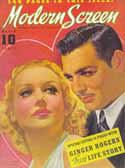 MGM stars Clark Gable and Joan Crawford (who were paired in eight films
- the first of which appeared in 1930) were crowned the "King and
Queen" of Hollywood (Tinseltown) in 1937 at the El Capitan Theater,
after a popularity poll. (Leading lady Myrna Loy was also crowned with
Gable). After a few small roles in silents, Clark Gable, the future King
of Hollywood, was first noticed by the public in Susan Lenox: Her Fall
and Rise (1931) with co-star Greta Garbo, then in a hot romantic pairing
opposite Joan Crawford in Possessed (1931), and next co-starring
with Jean Harlow and Mary Astor in the sensationally steamy drama Red
Dust (1932). Famed gangster John Dillinger was gunned down outside
Chicago's Biograph Theater on July 22, 1934 after viewing Gable in the
crime drama Manhattan Melodrama (1934). The Hollywood community
(and world) were stunned when in June of 1937, sexy actress Jean Harlow
passed away from a serious bladder infection, in the midst of filming
Saratoga (1937) for MGM with Gable. MGM stars Clark Gable and Joan Crawford (who were paired in eight films
- the first of which appeared in 1930) were crowned the "King and
Queen" of Hollywood (Tinseltown) in 1937 at the El Capitan Theater,
after a popularity poll. (Leading lady Myrna Loy was also crowned with
Gable). After a few small roles in silents, Clark Gable, the future King
of Hollywood, was first noticed by the public in Susan Lenox: Her Fall
and Rise (1931) with co-star Greta Garbo, then in a hot romantic pairing
opposite Joan Crawford in Possessed (1931), and next co-starring
with Jean Harlow and Mary Astor in the sensationally steamy drama Red
Dust (1932). Famed gangster John Dillinger was gunned down outside
Chicago's Biograph Theater on July 22, 1934 after viewing Gable in the
crime drama Manhattan Melodrama (1934). The Hollywood community
(and world) were stunned when in June of 1937, sexy actress Jean Harlow
passed away from a serious bladder infection, in the midst of filming
Saratoga (1937) for MGM with Gable.
Tragically,
Gable appeared in only one film - No Man of Her Own (1932) - with
his own wife Carole Lombard (she died in an airplane crash in early 1942).
Among the films that increased Clark Gable's popular pre-eminence in films
was director Frank Capra's hit It Happened One
Night (1934) (in which his removal of a shirt revealed his bare
chest and the absence of an undershirt - setting the US underwear industry
into a tailspin). In a strange twist of fate, Gable had been loaned out
to Columbia to make It Happened One Night (1934)
and ended up winning his first (and only) Best Actor award with the rival
studio.
Other films that propelled Gable further into stardom, upon his return
to MGM, were Mutiny on the Bounty (1935),
The Call of the Wild (1935), one of MGM's most successful films
and one of the earliest 'disaster' films - San Francisco (1936)
(known for its spectacular 20-minute earthquake sequence), Test Pilot
(1938), and of course, Gone with the Wind (1939)
with Gable's most famous leading role as roguish Rhett Butler in Margaret
Mitchell's best-selling story.
The Effects of the Depression on the Film Industry:
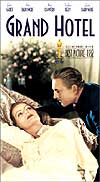 The Great Depression hit hard. Nearly all of the Hollywood studios (except
MGM) suffered financially during the early 30s, and studios had to reorganize,
request government assistance, cut budgets and employees, and close theatres
when profits plummeted. Attendance at theatres was drastically affected,
although during even the darkest days of the Depression, movie attendance
was still between 60-75 million per week. Special incentives and giveaways
(such as 2-for-1 features, dish nights, and other contests and attractions)
helped to maintain a patronizing audience. The balancing act for film-making
was to both reflect the realism and cynicism of the Depression period,
while also providing escapist entertainment to boost the morale of the
public by optimistically reaffirming values such as thrift and perseverance
(without offending the censors).
The Great Depression hit hard. Nearly all of the Hollywood studios (except
MGM) suffered financially during the early 30s, and studios had to reorganize,
request government assistance, cut budgets and employees, and close theatres
when profits plummeted. Attendance at theatres was drastically affected,
although during even the darkest days of the Depression, movie attendance
was still between 60-75 million per week. Special incentives and giveaways
(such as 2-for-1 features, dish nights, and other contests and attractions)
helped to maintain a patronizing audience. The balancing act for film-making
was to both reflect the realism and cynicism of the Depression period,
while also providing escapist entertainment to boost the morale of the
public by optimistically reaffirming values such as thrift and perseverance
(without offending the censors).
During most of the Depression Era, Hollywood responded
with expensive, mass-produced entertainment or escapist entertainment.
The best example of an all-star production heavily bankrolled by the
studios was MGM's Best Picture-winning Grand
Hotel (1932),
with "Garbo" (speaking her oft-quoted
line: "I want to be alone"),
John Barrymore, Joan Crawford, Wallace Beery,
and Lionel Barrymore. The film set a pattern
for future films, telling stories about the
lives and destinies of several individuals
- including a vivacious office stenographer,
a brusk unethical businessman, a ballerina
dancer, a gentleman jewel-thief, and a lowly
terminally-ill bookkeeper - that were woven
together into a whole.
The Decline - and Resurgence of Musicals: The Emergence of Busby
Berkeley
By 1932, Hollywood studios had glutted the public's tired appetite and
their overexposed song-and-dance epics (often sacrificing plot and character
development) went into a commercial decline, coinciding with the height
of the Great Depression. Audiences bypassed many of the musical films
that were being cranked out, and preferred to watch other genre creations,
such as the early gangster films:
Public Enemy (1931) and Little
Caesar (1930), the comedy film
Min and Bill (1930), or the Best Picture-winning western
film Cimarron (1931). The novelty of sound had worn off
and the popularity of musicals suffered.
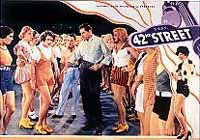 Fortunately, musicals produced at Warner Bros. reached their full flowering
by capturing the unique, innovative surrealistic choreography of Busby
Berkeley, who arranged dancers and chorus girls in geometric, kaleidoscopic
displays. Two of master choreographer Busby Berkeley's earliest films
(and the most popular of star Eddie Cantor's six films for Samuel Goldwyn)
were Whoopee (1930) and UA's The Kid From Spain (1932).
Berkeley's last choreographic work before leaving for Warner Bros. was
Roman Scandals (1933) - notorious for totally-nude, long-haired
slave girls (portrayed by the Goldwyn Girls). Fortunately, musicals produced at Warner Bros. reached their full flowering
by capturing the unique, innovative surrealistic choreography of Busby
Berkeley, who arranged dancers and chorus girls in geometric, kaleidoscopic
displays. Two of master choreographer Busby Berkeley's earliest films
(and the most popular of star Eddie Cantor's six films for Samuel Goldwyn)
were Whoopee (1930) and UA's The Kid From Spain (1932).
Berkeley's last choreographic work before leaving for Warner Bros. was
Roman Scandals (1933) - notorious for totally-nude, long-haired
slave girls (portrayed by the Goldwyn Girls).
The
first of Berkeley's choreographed-directed musicals for Warner
Bros. was Lloyd Bacon's backstage show 42nd Street
(1933). The successful musical inspired the Gold Diggers series
of films with more of Berkeley's trademark choreographing: Mervyn LeRoy's
Gold Diggers of 1933 (1933) (that included "We're in the Money"
with coin-clad chorus girls, "The Shadow Waltz" with swirling
chorines playing neon violins, and the moving, anti-Depression number
"Remember My Forgotten Man"), Gold Diggers of 1935 (1935) (famous
for Berkeley's "Lullaby of Broadway"), and In Caliente (1935).
The first of three film versions of A Star is Born (1937)
was the non-musical one in the late 30s - it starred Janet Gaynor and
Fredric March in the poignant, weeper/melodrama. [The best of all three
versions was the musical re-make A Star is Born
(1954) starring Judy Garland and James Mason.]
The romantic pairing of Jeanette MacDonald and Nelson
Eddy in the first of their eight films together began in 1935 with
their performances in Naughty Marietta (1935).
 Film History of the 1930s
Film History of the 1930s
Part 1, Part 2, Part 3, Part 4, Part 5, Part 6

 
|

